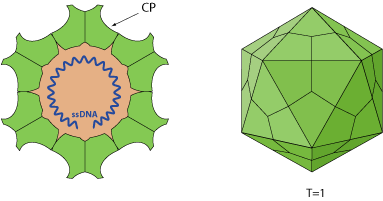Tetraparvovirus (taxid:1511911)
VIRION

Non-enveloped, round, T=1 icosahedral symmetry, 18-26 nm in diameter. The capsid consists of 60 copies of CP protein.
GENOME
Linear, ssDNA genome of about 4 to 6 kb in size. Both positive and negative strands are encapsidated, although the percentage of particles encapsidating the positive strand can be lower depending on the host cell. ORFs for both the structural and non-structural proteins are located on the same DNA strand.
The genome is replicated through rolling-hairpin mechanism.
GENE EXPRESSION
Host proteins transcribe the genomes into mRNAs. Alternative splicing allows expression of both structural and non-structural proteins.
ENZYMES
REPLICATION
NUCLEAR
- Attachement to host receptors initiates clathrin-mediated endocytosis of the virion into the host cell.
- The virion penetrates into the cytoplasm via permeabilization of host endosomal membrane.
- Microtubular transport of the virion toward the nucleus.
- The viral ssDNA genome penetrates into the nucleus.
- The ssDNA is converted into dsDNA by cellular proteins.
- dsDNA transcription gives rise to viral mRNAs when host cell enters S phase and translated to produce viral proteins.
- Replication occurs through rolling-hairpin mechanism, with NS1 endonuclease binding covalently to the 5' genomic end.
- Individual ssDNA genomes are excised from replication concatemers by a process called junction resolution.
- These newly synthesized ssDNA can either
a) be converted to dsDNA and serve as a template for transcription/replication
b) be encapsidated to form new virions that are released by cell lysis.
Host-virus interaction
Human parvovirus 4 G1 taxid:1511919
| Protein | ModelArchive |
| ORF1 | ma-jd-viral-23474 |
| ORF2 | ma-jd-viral-41330 |
Porcine parvovirus 2 taxid:1126383
| Protein | ModelArchive |
| Non-structural protein | ma-jd-viral-23471 |
| Structural protein CDS | ma-jd-viral-41344 |
Tetraparvovirus sp. taxid:1908804
| Protein | ModelArchive |
| NS1 | ma-jd-viral-23470 |
| VP1 | ma-jd-viral-41331 |
Tetraparvovirus ungulate1 taxid:3052771
| Protein | ModelArchive |
| Major structural protein | ma-jd-viral-07322 |
| Minor structural protein | ma-jd-viral-41354 |
| Nonstructural protein | ma-jd-viral-23468 |
